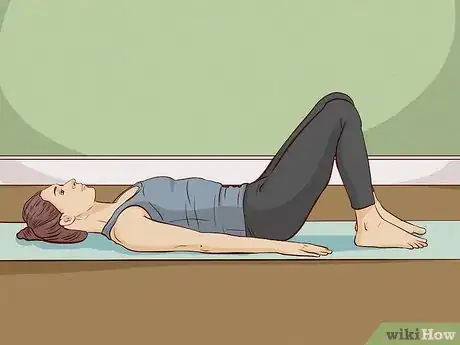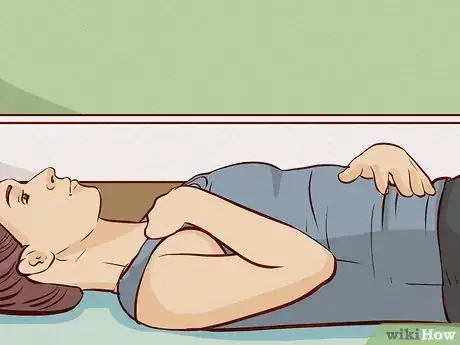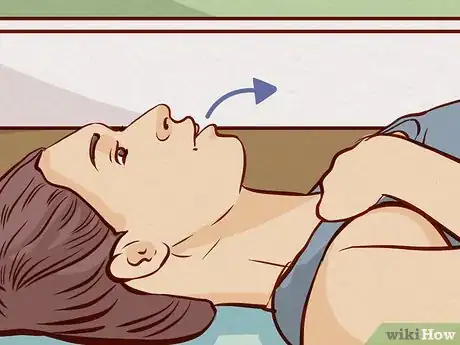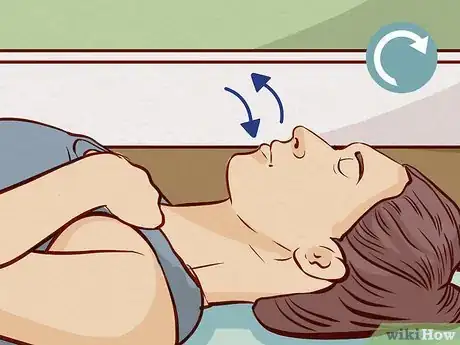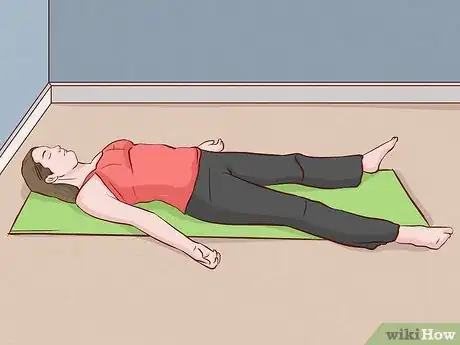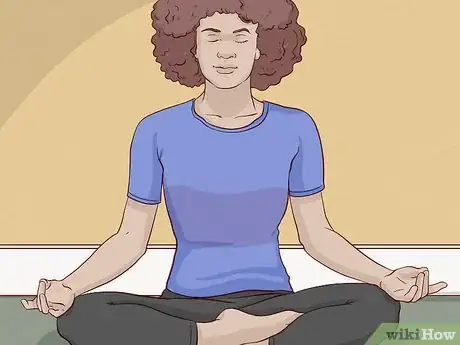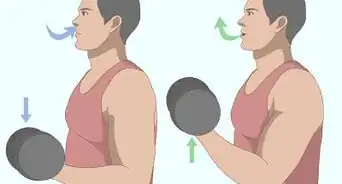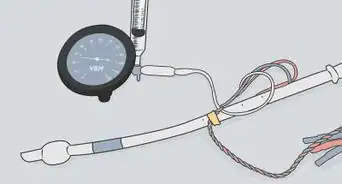This article was medically reviewed by Sarah Gehrke, RN, MS. Sarah Gehrke is a Registered Nurse and Licensed Massage Therapist in Texas. Sarah has over 10 years of experience teaching and practicing phlebotomy and intravenous (IV) therapy using physical, psychological, and emotional support. She received her Massage Therapist License from the Amarillo Massage Therapy Institute in 2008 and a M.S. in Nursing from the University of Phoenix in 2013.
There are 7 references cited in this article, which can be found at the bottom of the page.
wikiHow marks an article as reader-approved once it receives enough positive feedback. This article received 13 testimonials and 93% of readers who voted found it helpful, earning it our reader-approved status.
This article has been viewed 273,181 times.
Feel stressed or overwhelmed lately? Well, abdominal breathing may be just what you need! Abdominal or diaphragmatic breathing can help you strengthen your diaphragm muscles and breathe more efficiently. Not only is this breath work great for growing stronger lungs, but it can also help you relax and feel more at ease. Don’t believe us? Take a few minutes to try it out lying down or sitting up.
Steps
While Lying Down
-
1Take stock of your normal breathing. Before you practice abdominal breathing, pay attention to your normal patterns of breathing. Abdominal breathing should work to alter the normal pace and size of your breaths to promote relaxation.
- Close your eyes and pay attention to your breathing. Try to focus on your breaths and block out other stimulants like noises or smells. If possible, do this in a closed-off room away from distractions.
- Do you breathe into your chest or abdomen? Does your breathing feel slow? Fast? Are your breaths too shallow? See if there's anything about your breathing that feels abnormal. Doing occasional abdominal breathing exercises can help regulate normal breathing.
-
2Lie on your back and relax your body. Find a flat surface and lie down. Lie down on your back with your knees slightly bent and your feet flat against the surface. If you need extra support, put a pillow under your legs to keep your knees up.[1]Advertisement
-
3Place your hands on your chest and abdomen. Once you're lying down, it helps to position your hands in a way that will allow you to track your breathing. Place one hand on your upper chest and the other just below your ribcage. Relax your hands as much as you can, allowing your elbows to rest on the ground, bed, or sofa.[2]
-
4Inhale slowly through your nose. Once you're in a comfortable position, you can begin the breathing exercise. You should inhale into your abdomen, so the hand on your stomach moves upward while the hand on your chest remains as still as possible. You do not need to count, but you should inhale until you cannot comfortably take in more air. [3]
-
5Exhale slowly through your mouth or nose. As you exhale, tighten your stomach muscles. Push out as much air as you can by using your abdominal muscles as you exhale. Breathe through pursed lips as you let the breath out. Exhale until you cannot comfortably continue to breathe out.[4]
- As an alternative to breathing out through pursed lips, try the Ujjayi breathing technique. Keep your lips sealed and exhale through your nose. As you exhale, tighten the muscles in the back of your throat to push the breath out.
- Once you’re finished exhaling, repeat the exercise. Continue the exercise for about 5 to 10 minutes.[5]
-
6Repeat throughout the week. Abdominal breathing has several benefits. It strengthens your diaphragm, slows your breath rate, decreases your oxygen demand, and will eventually result in your breathing more efficiently overall. Do the exercise 3 to 4 times a day for 5 to 10 minutes, increasing the duration with time.[6]
- Even deep breathing for just 1-2 minutes on a busy day can help you relax and refocus.[7]
-
7Try abdominal breathing in the Savasana pose. The Savasana pose is a good position for abdominal breathing once you no longer need to track your breaths with your hands. Lie down flat on your back on a yoga mat or soft area rug. Spread your feet apart slightly, and let your arms rest at your sides with the palms up. Breathe in with your diaphragm for 5 counts, and then exhale for another 5 counts. As you maintain the pose, be aware of your breathing. Mentally scan each part of your body for tension, and consciously release any tension you find.[8]
-
8Experiment with different breathing patterns. Once you’ve gotten comfortable with abdominal breathing, practice different patterns, rates, and depths of breathing. Different types of abdominal breathing can slow down a stressed nervous system or even stimulate anti-inflammatory responses in your immune system.[9] Some techniques include:
- Breathing out for twice as long as you breath in. For example, you might breathe in for 5 counts, and breathe out for 10 counts. This will slow your heart rate and signal your nervous system to go into relaxation mode.
- Practicing the “Breath of Fire” technique, a form of rapid abdominal breathing. Breath of Fire involves breathing forcefully and quickly, inhaling and exhaling through your nose 2-3 times per second.[10] Do not try this technique on your own until you have mastered it with the guidance of an experienced yoga practitioner.
While Sitting
-
1Sit down. It is probably easier for you to initially practice abdominal breathing while lying down. However, as you get better at the activity it might be more efficient to do so while sitting. If you can do deep breathing exercises sitting, you'll be able to do so while out of your house. This might be more convenient as you can practice during downtime at work.[11]
- Sit down in a comfortable, firm chair. Keep your knees bent and your shoulders and neck relaxed.[12]
-
2Place your hands on your chest and abdomen. As you are mastering abdominal breathing, it helps to position your hands so that you can feel and track your breaths. Place one hand on your chest and another hand on your lower stomach. Your hands will help you tell if you're breathing correctly.[13]
-
3Breathe in and breathe out. Once you're seated with your hands in the right position, you can begin breathing. Inhale and exhale, and focus on the position of your hands as you do so.[14]
- Inhale through your nose, making sure the hand on your lower stomach rises while the hand on your chest remains relatively still. Inhale until you cannot take in any more air comfortably.[15]
- Contract your stomach muscles to exhale, breathing out through pursed lips or through your nose.[16]
- Continue this exercise for about 5 to 10 minutes.[17]
Expert Q&A
-
QuestionStrength training has caused my abdominal muscles to be quite a bit more developed than the average person. Should I expect this to make abdominal breathing more challenging? It feels strenuous.
 Sarah Gehrke, RN, MSSarah Gehrke is a Registered Nurse and Licensed Massage Therapist in Texas. Sarah has over 10 years of experience teaching and practicing phlebotomy and intravenous (IV) therapy using physical, psychological, and emotional support. She received her Massage Therapist License from the Amarillo Massage Therapy Institute in 2008 and a M.S. in Nursing from the University of Phoenix in 2013.
Sarah Gehrke, RN, MSSarah Gehrke is a Registered Nurse and Licensed Massage Therapist in Texas. Sarah has over 10 years of experience teaching and practicing phlebotomy and intravenous (IV) therapy using physical, psychological, and emotional support. She received her Massage Therapist License from the Amarillo Massage Therapy Institute in 2008 and a M.S. in Nursing from the University of Phoenix in 2013.
Registered Nurse Since it feels strenuous, your abdominal muscles are likely making the abdominal breathing challenging -- almost like you have created your own corset that restricts your diaphragm (not really, of course). Start slow with this practice and work your way up to more time. Focus on breathing exercises that will contribute to improved exhalation, such as pursing your lips and drawing your abdomen in gently as you exhale may, over time, help "free" the diaphragm.
Since it feels strenuous, your abdominal muscles are likely making the abdominal breathing challenging -- almost like you have created your own corset that restricts your diaphragm (not really, of course). Start slow with this practice and work your way up to more time. Focus on breathing exercises that will contribute to improved exhalation, such as pursing your lips and drawing your abdomen in gently as you exhale may, over time, help "free" the diaphragm.
References
- ↑ http://my.clevelandclinic.org/health/diseases_conditions/hic_Understanding_COPD/hic_Pulmonary_Rehabilitation_Is_it_for_You/hic_Diaphragmatic_Breathing
- ↑ http://my.clevelandclinic.org/health/diseases_conditions/hic_Understanding_COPD/hic_Pulmonary_Rehabilitation_Is_it_for_You/hic_Diaphragmatic_Breathing
- ↑ http://my.clevelandclinic.org/health/diseases_conditions/hic_Understanding_COPD/hic_Pulmonary_Rehabilitation_Is_it_for_You/hic_Diaphragmatic_Breathing
- ↑ http://my.clevelandclinic.org/health/diseases_conditions/hic_Understanding_COPD/hic_Pulmonary_Rehabilitation_Is_it_for_You/hic_Diaphragmatic_Breathing
- ↑ http://my.clevelandclinic.org/health/diseases_conditions/hic_Understanding_COPD/hic_Pulmonary_Rehabilitation_Is_it_for_You/hic_Diaphragmatic_Breathing
- ↑ http://my.clevelandclinic.org/health/diseases_conditions/hic_Understanding_COPD/hic_Pulmonary_Rehabilitation_Is_it_for_You/hic_Diaphragmatic_Breathing
- ↑ https://www.va.gov/vetsinworkplace/docs/em_eap_exercise_breathing.asp
- ↑ http://www.yogabasics.com/asana/corpse/
- ↑ https://www.ncbi.nlm.nih.gov/pmc/articles/PMC4034215/
- ↑ http://www.thesecretsofyoga.com/breathing/breath-of-fire.html
- ↑ https://www.uofmhealth.org/health-library/uz2255
- ↑ http://my.clevelandclinic.org/health/diseases_conditions/hic_Understanding_COPD/hic_Pulmonary_Rehabilitation_Is_it_for_You/hic_Diaphragmatic_Breathing
- ↑ http://my.clevelandclinic.org/health/diseases_conditions/hic_Understanding_COPD/hic_Pulmonary_Rehabilitation_Is_it_for_You/hic_Diaphragmatic_Breathing
- ↑ https://www.health.harvard.edu/lung-health-and-disease/learning-diaphragmatic-breathing
- ↑ http://my.clevelandclinic.org/health/diseases_conditions/hic_Understanding_COPD/hic_Pulmonary_Rehabilitation_Is_it_for_You/hic_Diaphragmatic_Breathing
- ↑ http://my.clevelandclinic.org/health/diseases_conditions/hic_Understanding_COPD/hic_Pulmonary_Rehabilitation_Is_it_for_You/hic_Diaphragmatic_Breathing
- ↑ http://my.clevelandclinic.org/health/diseases_conditions/hic_Understanding_COPD/hic_Pulmonary_Rehabilitation_Is_it_for_You/hic_Diaphragmatic_Breathing
About This Article
To do abdominal breathing, start by lying down or sitting in a comfortable, firm chair. Additionally, place one hand on your chest and the other on your abdomen to help you track your breathing. Then, breathe in through your nose and fill your abdomen with air so that the hand on your stomach rises, while the hand on your chest remains still. Next, exhale slowly as you tighten your stomach muscles to push out the air. Repeat this exercise for up to 10 minutes 3 times a day to strengthen your diaphragm. For tips from our Medical reviewer on how to experiment with different breathing patterns to reduce stress or inflammation, read on!

